THE HISTORY OF THE WWI FIGHTING KNIFE
Knives have been a key fighting weapon in every war. No matter how advanced the technology, a good knife always has a place in battle.
A special breed of knives saw extensive development during WWI. Known as the "fighting knife". While it could be employed for the uses of a regular knife, its primary goal was for hand-to-hand combat. The design, balance and materials employed varied from the run of the mill knife.
This page provides a sample of the various fighting knives used during WWI and beyond. The samples displayed here cover various countries that participated in the war. Information provided includes the identification of fighting knives and pricing of fighting knives.
THE US MARK I TRENCH KNIFE
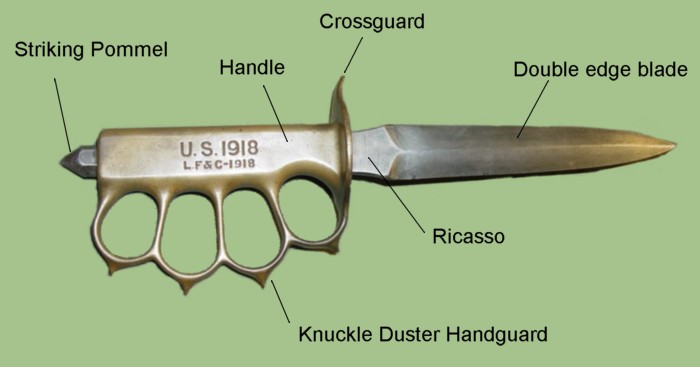
The Mark I trench knife was an American trench knife designed for use in World War I. It had a 6.75 in double edged dagger blade useful for stabbing and cutting which other trench knives such as the 1917/1918 were not. The handle was actually made of cast bronze, which used a conical steel nut to hold the blade in. The Mark I's blade was blackened with a gun blue type finish, the bronze handle was chemically blackened, with spikes formed on each knuckle bow. These spikes were intended to prevent an opponent from grabbing the knife hand, as well as to improve the striking power.
WWI TRENCH KNIFE HANDLES
The trench knives were designed for close combatapplications. An enemy soldier may sneak into the trench in the middle of
the night. There may not be time or space to reach for the rifle. The knife was the best weapon to dispatch the
agressor. The blade of the knife was not the only weapon, the handle was also used as a striking surface.
The following section covers some of the handles that doubled as weapons:
WWI TRENCH KNIFE BLADES
The blades of the trench knives were designed to kill the opponent. There were two main categories for the blades
which are covered in this section.
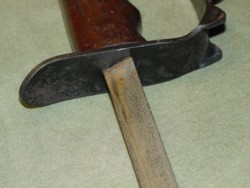 |
This is a triangular blade. Designed to perform two funtions; one was to penetrate German helmets and deliver a
deadly blow to the head. the other was to inflict hard to sew wounds to an enemy combatant.
The blade tapers down into a point. The edges of the weapon are not sharp. This is a thrusting blade as opposed
to a slashing type. The blade does not have any markings stamped on it.
|
The second type of blade found in the trench knives follows. The shape is more like a regular fighting knife.
Of double edge construction with a fairly large ricasso that converges into a point that forms the fuller of the
blade.
This is more of a slashing weapon. The blade does not have any markings stamped on it.
WWI TRENCH KNIVES MARKINGS
Most of the WWI trench knives were marked with the manufacturer's name, year of production or US, to indicate United
States. The markings were applied in different areas. The following photographs illustrate some of the locations
of the markings.
WWI TRENCH KNIVES SCABBARD
The trench knives came with a variety of scabbards. Some of them were manufactured from leather, others from metal and
yet a third type from a combiantion of both. some of the scabbards were factory produced while others were theater
made.
The main body of the scabbard is constructed with heavy, thick leather. White cotton thread is employed to
close the seam at one end.
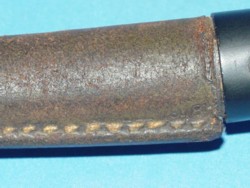 |
The leather scabbard for the spike trench knife was made of heavy duty leather. The throat and the tip were made
of metal. The throat was equipped with a hanging device.
The metal pieces are attached to the main body via the use of circular rivets.
|
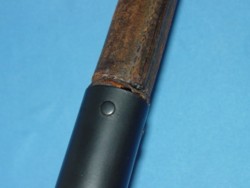 |
The following is an example of a theater made scabbard. Constructed of brown leather. The edges have been sewn
with heavy duty white cotton thread. the top of the scabbard has a couple of slits cut to allow the belt to
go through.
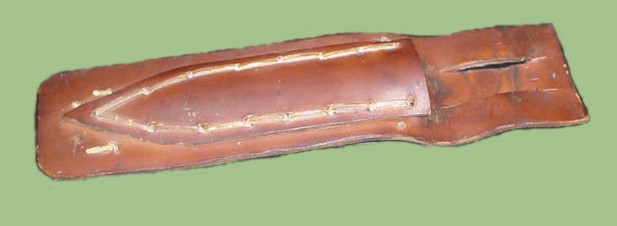
If you have an interest is seeing other fighting knives, you can do so by going to our
Military Fighting Knives Price Guide
identification page. Where we cover Army, Navy, Army Air Force, USMC and other military groups.
While the knives shown on this page are not for sale, you can visit our website,
MilitaryItems.com ,
to see other military and non-military knives available for sale.
|







